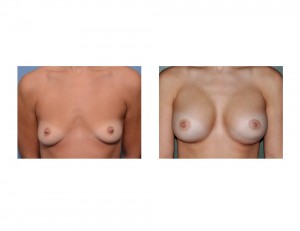Background: While the concept of inserting a breast implant seems easy, there are numerous aesthetic considerations of which to be aware. Besides the nipples, the inframammary fold (IMF) or lower breast fold is the most important anatomic landmark of the breast. The IMF creates a clear demarcation between the breast and the chest/abdomen which lies below it. It is actually a ligament formed by the fusion of the superficial fascia to the dermis of the skin.
While it is traditionally taught that the IMF should not be violated during breast augmentation, it is unavoidable in many cases. A small breast has by definition a narrow base diameter vertically. Depending on the size of the chosen implant, keeping the fold intact will often result in a breast implant that is positioned too high. Deliberately lowering the fold can also be help in breasts that have a small degree of sagging or ptosis as long as the nipple does not hang below the horizontal level of the fold.
But lowering the IMF does have its own risks which are well known. Loss of this fixed structure (without recreating it) can result in breast implants bottoming out due to loss of support. In addition, even with good implant positioning, a persistent crease in the skin at the former level of the IMF can persist due to dermal creasing.
Case Study: This 30 year-old female desired to have much large and fuller breasts. Whatever breast tissue she had was largely lost after multiple pregnancies. Her breasts were not only small but they were widely spaced. In addition the left breast (her left) was slightly smaller with a higher inframammary fold. She wanted to go from her A/B to a full D cup.


Different sized breasts, when they are small, seem inconsequential and often unrecognized. But when the breasts become enlarged by any amount with implants, such small differences can become apparent and can affect the final result in terms of breast symmetry. Having to lower the fold on a smaller breast to match the other side runs the risk of potential bottoming out or a persistent skin crease across the lower breast pole.
Case Highlights:
1) Many breast augmentations require lowering the existing inframammary fold to accomodate the size of a breast implant.
2) Lowering the inframammary fold in breast augmentation creates the potential for fold complications which is a risk some women must take who have small breasts with high folds.
3) A persistent crease on the lower pole of the breast can occur when the fold is lowered which may or may not resolve with time and healing.
Dr. Barry Eppley
Indianapolis, Indiana


